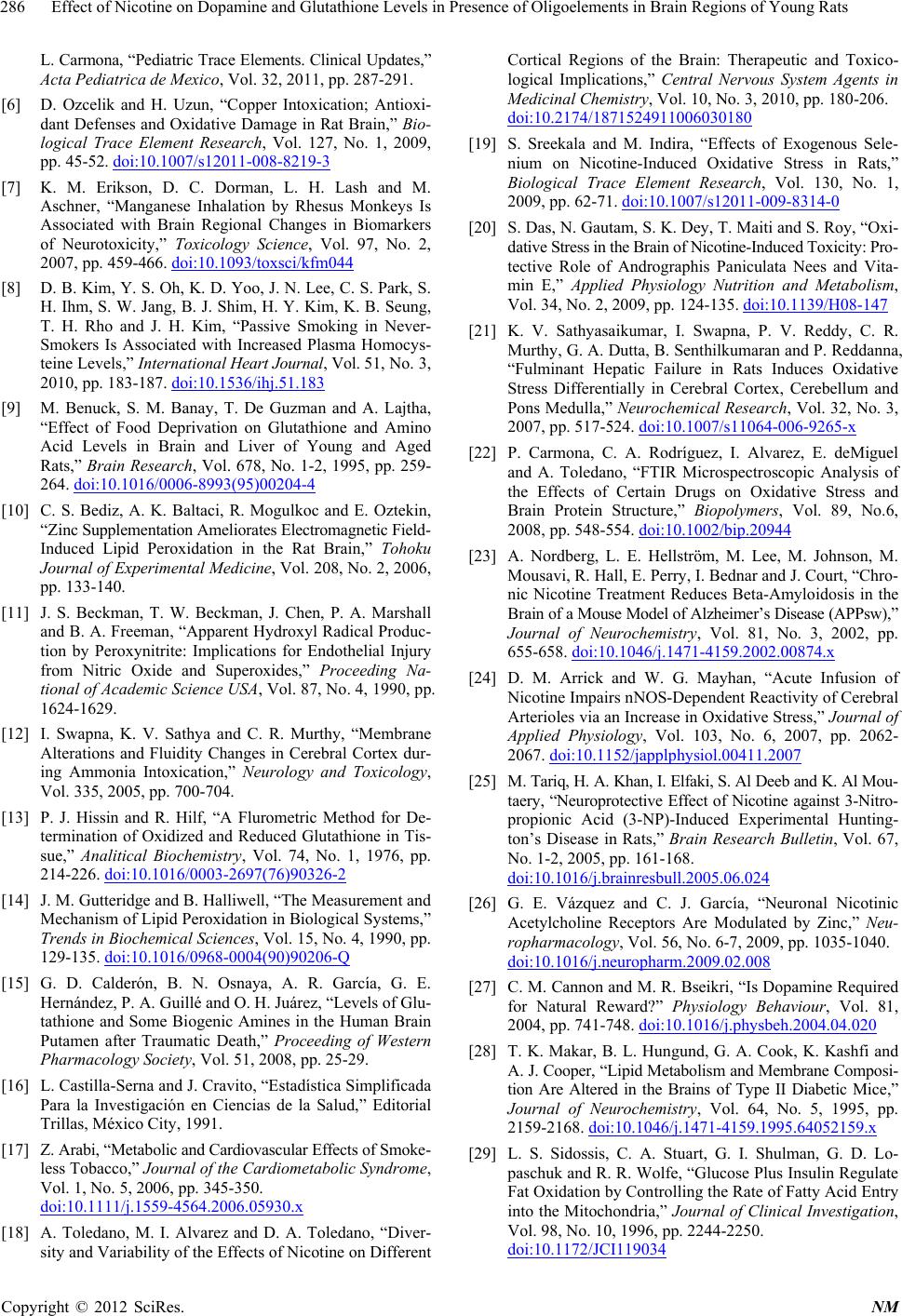
Effect of Nicotine on Dopamine and Glutathione Levels in Presence of Oligoelements in Brain Regions of Young Rats
286
L. Carmona, “Pediatric Trace Elements. Clinical Updates,”
Acta Pediatrica de Mexico, Vol. 32, 2011, pp. 287-291.
[6] D. Ozcelik and H. Uzun, “Copper Intoxication; Antioxi-
dant Defenses and Oxidative Damage in Rat Brain,” Bio-
logical Trace Element Research, Vol. 127, No. 1, 2009,
pp. 45-52. doi:10.1007/s12011-008-8219-3
[7] K. M. Erikson, D. C. Dorman, L. H. Lash and M.
Aschner, “Manganese Inhalation by Rhesus Monkeys Is
Associated with Brain Regional Changes in Biomarkers
of Neurotoxicity,” Toxicology Science, Vol. 97, No. 2,
2007, pp. 459-466. doi:10.1093/toxsci/kfm044
[8] D. B. Kim, Y. S. Oh, K. D. Yoo, J. N. Lee, C. S. Park, S.
H. Ihm, S. W. Jang, B. J. Shim, H. Y. Kim, K. B. Seung,
T. H. Rho and J. H. Kim, “Passive Smoking in Never-
Smokers Is Associated with Increased Plasma Homocys-
teine Levels,” Intern ational Heart Journal, Vol. 51, No. 3,
2010, pp. 183-187. doi:10.1536/ihj.51.183
[9] M. Benuck, S. M. Banay, T. De Guzman and A. Lajtha,
“Effect of Food Deprivation on Glutathione and Amino
Acid Levels in Brain and Liver of Young and Aged
Rats,” Brain Research, Vol. 678, No. 1-2, 1995, pp. 259-
264. doi:10.1016/0006-8993(95)00204-4
[10] C. S. Bediz, A. K. Baltaci, R. Mogulkoc and E. Oztekin,
“Zinc Supplementation Ameliorates Electromagnetic Field-
Induced Lipid Peroxidation in the Rat Brain,” Tohoku
Journal of Experimental Medicine, Vol. 208, No. 2, 2006,
pp. 133-140.
[11] J. S. Beckman, T. W. Beckman, J. Chen, P. A. Marshall
and B. A. Freeman, “Apparent Hydroxyl Radical Produc-
tion by Peroxynitrite: Implications for Endothelial Injury
from Nitric Oxide and Superoxides,” Proceeding Na-
tional of Academic Science USA, Vol. 87, No. 4, 1990, pp.
1624-1629.
[12] I. Swapna, K. V. Sathya and C. R. Murthy, “Membrane
Alterations and Fluidity Changes in Cerebral Cortex dur-
ing Ammonia Intoxication,” Neurology and Toxicology,
Vol. 335, 2005, pp. 700-704.
[13] P. J. Hissin and R. Hilf, “A Flurometric Method for De-
termination of Oxidized and Reduced Glutathione in Tis-
sue,” Analitical Biochemistry, Vol. 74, No. 1, 1976, pp.
214-226. doi:10.1016/0003-2697(76)90326-2
[14] J. M. Gutteridge and B. Halliwell, “The Measurement and
Mechanism of Lipid Peroxidation in Biological Systems,”
Trends in Biochemical Sciences, Vol. 15, No. 4, 1990, pp.
129-135. doi:10.1016/0968-0004(90)90206-Q
[15] G. D. Calderón, B. N. Osnaya, A. R. García, G. E.
Hernández, P. A. Guillé and O. H. Juárez, “Levels of Glu-
tathione and Some Biogenic Amines in the Human Brain
Putamen after Traumatic Death,” Proceeding of Western
Pharmacology Society, Vol. 51, 2008, pp. 25-29.
[16] L. Castilla-Serna and J. Cravito, “Estadística Simplificada
Para la Investigación en Ciencias de la Salud,” Editorial
Trillas, México City, 1991.
[17] Z. Arabi, “Metabolic and Cardiovascular Effects of Smoke-
less Tobacco,” Journal of the Cardiometabolic Syndrome,
Vol. 1, No. 5, 2006, pp. 345-350.
doi:10.1111/j.1559-4564.2006.05930.x
[18] A. Toledano, M. I. Alvarez and D. A. Toledano, “Diver-
sity and Variability of the Effects of Nicotine on Different
Cortical Regions of the Brain: Therapeutic and Toxico-
logical Implications,” Central Nervous System Agents in
Medicinal Chemistry, Vol. 10, No. 3, 2010, pp. 180-206.
doi:10.2174/1871524911006030180
[19] S. Sreekala and M. Indira, “Effects of Exogenous Sele-
nium on Nicotine-Induced Oxidative Stress in Rats,”
Biological Trace Element Research, Vol. 130, No. 1,
2009, pp. 62-71. doi:10.1007/s12011-009-8314-0
[20] S. Das, N. Gautam, S. K. Dey, T. Maiti and S. Roy, “Oxi-
dative Stress in the Brain of Nicotine-Induced Toxicity: Pro-
tective Role of Andrographis Paniculata Nees and Vita-
min E,” Applied Physiology Nutrition and Metabolism,
Vol. 34, No. 2, 2009, pp. 124-135. doi:10.1139/H08-147
[21] K. V. Sathyasaikumar, I. Swapna, P. V. Reddy, C. R.
Murthy, G. A. Dutta, B. Senthilkumaran and P. Reddanna,
“Fulminant Hepatic Failure in Rats Induces Oxidative
Stress Differentially in Cerebral Cortex, Cerebellum and
Pons Medulla,” Neurochemical Research, Vol. 32, No. 3,
2007, pp. 517-524. doi:10.1007/s11064-006-9265-x
[22] P. Carmona, C. A. Rodríguez, I. Alvarez, E. deMiguel
and A. Toledano, “FTIR Microspectroscopic Analysis of
the Effects of Certain Drugs on Oxidative Stress and
Brain Protein Structure,” Biopolymers, Vol. 89, No.6,
2008, pp. 548-554. doi:10.1002/bip.20944
[23] A. Nordberg, L. E. Hellström, M. Lee, M. Johnson, M.
Mousavi, R. Hall, E. Perry, I. Bednar and J. Court, “Chro-
nic Nicotine Treatment Reduces Beta-Amyloidosis in the
Brain of a Mouse Model of Alzheimer’s Disease (APPsw),”
Journal of Neurochemistry, Vol. 81, No. 3, 2002, pp.
655-658. doi:10.1046/j.1471-4159.2002.00874.x
[24] D. M. Arrick and W. G. Mayhan, “Acute Infusion of
Nicotine Impairs nNOS-Dependent Reactivity of Cerebral
Arterioles via an Increase in Oxidative Stress,” Journal of
Applied Physiology, Vol. 103, No. 6, 2007, pp. 2062-
2067. doi:10.1152/japplphysiol.00411.2007
[25] M. Tariq, H. A. Khan, I. Elfaki, S. Al Deeb and K. Al Mou-
taery, “Neuroprotective Effect of Nicotine against 3-Nitro-
propionic Acid (3-NP)-Induced Experimental Hunting-
ton’s Disease in Rats,” Brain Research Bulletin, Vol. 67,
No. 1-2, 2005, pp. 161-168.
doi:10.1016/j.brainresbull.2005.06.024
[26] G. E. Vázquez and C. J. García, “Neuronal Nicotinic
Acetylcholine Receptors Are Modulated by Zinc,” Neu-
ropharmacology, Vol. 56, No. 6-7, 2009, pp. 1035-1040.
doi:10.1016/j.neuropharm.2009.02.008
[27] C. M. Cannon and M. R. Bseikri, “Is Dopamine Required
for Natural Reward?” Physiology Behaviour, Vol. 81,
2004, pp. 741-748. doi:10.1016/j.physbeh.2004.04.020
[28] T. K. Makar, B. L. Hungund, G. A. Cook, K. Kashfi and
A. J. Cooper, “Lipid Metabolism and Membrane Composi-
tion Are Altered in the Brains of Type II Diabetic Mice,”
Journal of Neurochemistry, Vol. 64, No. 5, 1995, pp.
2159-2168. doi:10.1046/j.1471-4159.1995.64052159.x
[29] L. S. Sidossis, C. A. Stuart, G. I. Shulman, G. D. Lo-
paschuk and R. R. Wolfe, “Glucose Plus Insulin Regulate
Fat Oxidation by Controlling the Rate of Fatty Acid Entry
into the Mitochondria,” Journal of Clinical Investigation,
Vol. 98, No. 10, 1996, pp. 2244-2250.
doi:10.1172/JCI119034
Copyright © 2012 SciRes. NM